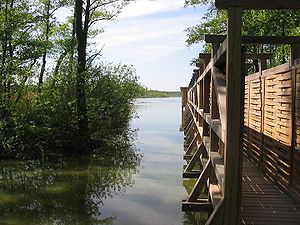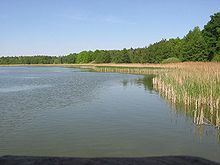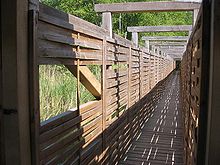Riebener See
| Riebener See | ||
|---|---|---|

|
||
| Geographical location | Germany , Brandenburg | |
| Tributaries | none | |
| Drain | Vohskutengraben → Pfeffergraben → Pfefferfließ → Nieplitz → Nuthe → Havel → Elbe | |
| Places on the shore | Rieben , district of Beelitz | |
| Location close to the shore | Trebbin | |
| Data | ||
| Coordinates | 52 ° 11 '31 " N , 13 ° 3' 6" E | |
|
|
||
| Altitude above sea level | 34 m above sea level NN | |
| surface | 38 ha | |
| length | 1 km | |
| width | 600 m | |
| Middle deep | 1 m | |
|
particularities |
The lake is under nature protection; Bird observation pier |
|

|
||
The Riebener See (Slavic ryba = fish ) is a eutrophic, clear water shallow lake and therefore a rather rare type of water for Brandenburg . It is located in the Nuthe-Nieplitz Nature Park near the village of the same name, Rieben , a district of the town of Beelitz in the Potsdam-Mittelmark district . The nature-protected water with the shape of a snail extends from west to east over a length of almost one kilometer and has a maximum width of around 600 meters.
Natural integration
The silting, reed -covered banks of the Riebener See are largely swampy and inaccessible. Bathing and fishing are prohibited. The entire body of water is a valuable biotope and bird refuge and breeding area . It belongs to a chain of lakes in the Nuthe-Nieplitz-Niederung, which was formed around 20,000 years ago at the end of the Vistula Ice Age as an interurge valley between the thawing glaciers.
The lake is located on the southeastern edge of the Neuse area near Stangenhagen in the area of Nieplitz , Pfefferfließ and an extensive ditch system, which has been renatured into a former fen since the pumping stations were shut down in 1991 and their dismantling in 2000/01 . With the rise of the groundwater level , the dams on the Pfefferfließ could be lifted. Since 2004 the natural runoff, the long filled Vohskutengraben from the Riebener See to the Pfeffergraben has been restored. For fish and other water hikers, the path over the Pfefferfließ and the Nieplitz to the Blankensee is passable. The groundwater-fed lake has no inflow.
Flora and fauna
Since the abandonment of intensive fishing and the fattening of ducks on the shore around 1992, the lake has again developed into a bird paradise and the polluted water has recovered. The protection and preservation of its ecological function has been a priority since the acquisition by the Landschafts-Förder-Verein Nuthe-Nieplitz-Niederung e. V. secured sustainably in 2001.
flora
The lake is surrounded by a dense reed beds and alder-lined swamps in the silted surrounded riparian zone, which hardly permitted a view of the lake before the construction of the planks way. The water of the Riebener See is much clearer than that of the neighboring Blankensee and Grössinsees . The depth of view extends to the ground and the ground is covered by an almost closed plant cover .
Bird breeding area and boardwalk
The calm and secluded lake is a preferred resting, sleeping and breeding place for birds. In addition, several thousand of the area's 60,000 Nordic geese overwinter in the lake. A cormorant colony has firmly established itself on the old trees of a peninsula . Warbler , Pochard , grebes , little grebes , cranes and swans are native to the lake. The guest performance of a bittern ( Botaurus stellaris ) in recent years gives nature conservationists hope that this sensitive and strictly protected bird will one day also be part of the population. The Marsh Harrier ( Circus aeruginosus ), which is particularly protected throughout Europe and threatened with extinction in Germany, is already one of the lake dwellers.

Since 2006, a boardwalk with a viewing platform has provided a view of the entire lake. The footbridge at the former lake drain extends around 20 meters through the reed belt into the lake and is clad with wood on both sides to protect the fauna. The cladding allows many views. The realization took place within the scope of the land reorganization in Rieben with the aim of reconciling the interests of nature conservation with the wishes of bird watchers and tourism.
Fish and amphibian protection
The lake, which was heavily fished until 1992 , is now only occasionally used with a boat to empty the eel traps . The residents include in particular carp fish such as roach , lead or bream . The lake, with its marshy shores and adjacent meadows, is a preferred area for frogs , toads and newts . The endangered natterjack toad is one of the seven identified amphibian species . The moor frog is the most common.
To protect their migrations, toad fences have been set up since the steady increase in road traffic on Landstrasse 73 between Rieben and Zauchwitz . Investigations had shown that even a traffic volume of 20 vehicles / hour led to a loss of 20% of the population and that from 60 vehicles / hour the crawling and hopping animals hardly had a chance to cross the street unscathed. In 1993 around 2,000 amphibians were counted in the collecting bins of the protective fences . In February / March 1998 there were already 10,000, not least thanks to the protective measures. With these data, an amphibian guidance system was implemented during the expansion of the road in 1998 as a compensatory measure for the encroachment on nature, which consists of five toad tunnels at a distance of 50 meters. Subsequent investigations showed that the system has proven itself. The abundance of amphibians contributes to the fact that the heraldic animal of the Nuthe Nieplitz Nature Park, the white stork , is particularly common at Riebener See.
Settlement of the lake
Although the name of the lake is derived from the Slavic ryba = fish , it can be proven that it was first settled around 1335, around 300 years after the Slavic period. At that time, the lake reached as far as the village of the same name, Rieben, which is around three hundred meters away today. For a long time village life was determined by the lake. In order to gain access to the surrounding marshland, the Vohskutengraben was filled in at an early stage and a dam with a weir to regulate the water level was built elsewhere.
See also
literature
- Peter Koch; Stork breakfast in the ditch . In: Landschaftsförderverein Nuthe-Nieplitz-Niederung e. V. (Hrsg.): Land in Sicht, magazine for a socially and nature-friendly development of the Nuthe-Nieplitz region . Stücken , Issue 7 2002/2003, pp. 21f, ISSN 0946-6762 .
- Peter Koch: Great prospects , in: Landschaftsförderverein Nuthe-Nieplitz-Niederung e. V. (Hrsg.): Land in Sicht, magazine for a socially and nature-friendly development of the Nuthe-Nieplitz region . Pieces, issue June 9, 2006, p. 29f, ISSN 0946-6762 .
- Carsten Rasmus, Bettina Klaehne: Hiking and nature guides in the Nuthe-Nieplitz Nature Park. Hikes, bike rides and walks. KlaRas, Berlin 2001. ISBN 3-933135-11-7 . Pp. 24, 39f.
- Rubbing comes from "ryba" . In: Landschaftsförderverein Nuthe-Nieplitz-Niederung e. V. (Hrsg.): Land in Sicht, magazine for a socially and nature-friendly development of the Nuthe-Nieplitz region . Stücken , Issue 7 2002/2003, pp. 19f, ISSN 0946-6762 .
- From Blankensee to Riebener See - finally without any obstacles . In: Landschaftsförderverein Nuthe-Nieplitz-Niederung e. V. (Hrsg.): Land in Sicht, magazine for a socially and nature-friendly development of the Nuthe-Nieplitz region . Pieces, issue June 8, 2004, p. 33, ISSN 0946-6762 .
Web links
- The waters of the Nuthe-Nieplitz-Niederung - website of the ornithological working group in the Landscape Funding Association Nuthe-Nieplitz-Niederung e. V.


